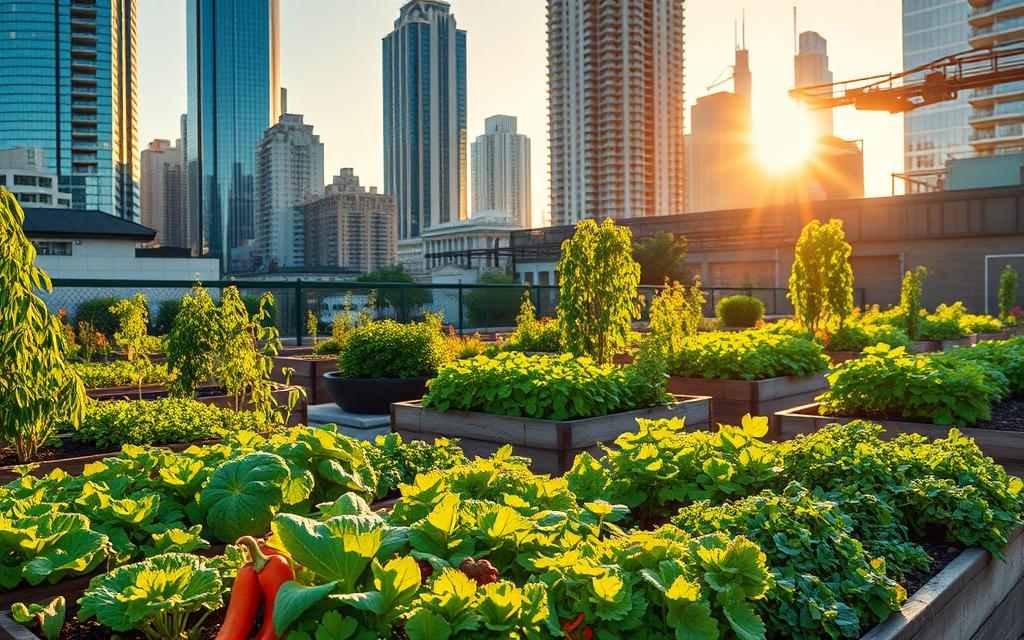Advertisement
Did you know over 30% of households in the United States don’t have a backyard? Yet, many still want to grow their own food. Community gardens are the answer. They offer shared spaces for growing fruits, vegetables, and flowers.
Nourishing communities through green spaces, these gardens do more than just grow food. They also bring people together, creating a sense of community and connection.
Joining a community garden lets you grow your own food without needing a backyard. This way of living is becoming more popular in the United States.
What is Urban Gardening?
Urban gardening is changing how we grow food in cities. It uses rooftops, balconies, and community gardens for planting. This way, city folks can grow their own food and help the environment.
Understanding the Concept of Urban Gardening means seeing how it changes city spaces. It includes container, vertical, and raised bed gardening. These methods help people use small spaces in big cities.
Understanding the Concept of Urban Gardening
Urban gardening is more than growing plants. It’s about making cities greener and healthier. By gardening, people can lower their carbon footprint and help the environment. It also brings people together, as many gardens are community efforts.
Sustainable urban agriculture is key in urban gardening. It focuses on growing food in a way that’s good for the planet and people. This approach benefits both the gardener and the community.
The Benefits of Practicing Urban Gardening
Urban gardening has many benefits. It gives people fresh food, makes cities look better, and helps the environment. Gardens in cities can be green spaces, improving air and cooling down the city.
| Benefits | Description |
|---|---|
| Fresh Produce | Urban gardening lets people grow their own food, giving them healthy produce. |
| Environmental Sustainability | Using city spaces for gardens helps reduce pollution and improve air quality. |
| Community Building | Urban gardens are places where people meet and connect with each other. |
As urban gardening grows, it’s clear it’s good for everyone. By supporting urban horticulture, city dwellers can make their homes greener and better.

Advantages of Community Gardens
Community gardens are more than just places to grow food. They turn urban areas into lively spots. These gardens help people connect, support sustainability, and make city living better.
Strengthening Community Bonds
Community gardens are great at bringing people together. They let people from different backgrounds share and learn from each other. This builds a strong community feeling.
They act as social centers, where folks can meet, eat, and join in on activities. This is key in cities, where people might feel alone or cut off from others.
Enhancing Food Security
Community gardens help make sure everyone has access to fresh food. Gardeners grow their own veggies and fruits. This means they always have healthy food on hand.
Having fresh produce is good for your health. It also saves money on grocery bills. This is a big win for gardeners.
| Benefits | Description | Impact |
|---|---|---|
| Social Benefits | Fosters community spirit, reduces isolation | Stronger community bonds |
| Food Security | Increases access to fresh, healthy produce | Improved health outcomes |
| Economic Benefits | Saves money on grocery bills | Economic savings for gardeners |
Understanding the good that community gardens do helps us see their value. They make cities more sustainable, connected, and healthy.
Getting Started with Community Gardening
Starting a community garden might seem hard, but it’s actually rewarding. It’s not just about growing food; it’s about creating a community. You can garden on a balcony or rooftop, using rooftop and vertical gardening.
Finding a Local Community Garden
To begin, search for community gardens near you. Look online or check local boards. Many cities have websites or social media for urban gardening.
After finding a garden, contact the organizers. They can tell you about their activities and how to join.
Joining or Forming a Gardening Group
If there’s no garden near you, start one. Gather people from your neighborhood or work.
Find a good spot, like a vacant lot or rooftop. Then, plan your garden’s layout and rules.
Community gardening includes rooftop gardening and vertical gardening. These are great for small spaces in cities.
| Gardening Method | Space Requirement | Initial Investment |
|---|---|---|
| Rooftop Gardening | Variable | Moderate to High |
| Vertical Gardening | Minimal | Low to Moderate |
| Traditional Community Gardening | Significant | Low |
By following these steps, you can start or join a community garden. It lets you grow your own food and builds community spirit. It also supports sustainable living.
Essential Supplies for Community Gardening
Community gardening needs careful planning of essential supplies. The right tools, equipment, soil, and fertilizers are key. They ensure a good harvest and support sustainable urban agriculture.
Tools and Equipment You’ll Need
A successful community garden starts with the right tools and equipment. Here are some must-haves:
- Gardening gloves for protection
- Hand trowels and shovels for planting
- Rakes for soil preparation and maintenance
- Watering cans or hoses for efficient irrigation
- Garden forks for turning over soil
Durable, high-quality tools are crucial for a productive garden. For urban gardening, look for space-saving options too.
Choosing the Right Soil and Fertilizers
The quality of soil and fertilizers greatly affects a garden’s success. For urban farming and gardening, choose soil that’s nutrient-rich and drains well.
There are many fertilizers to consider:
| Fertilizer Type | Description | Benefits |
|---|---|---|
| Organic Compost | Made from decomposed organic matter | Rich in nutrients, improves soil structure |
| Synthetic Fertilizers | Man-made, precise nutrient content | Quick acting, can be formulated for specific needs |
| Green Manure | Plants incorporated into the soil | Adds nutrients, improves soil health |
For sustainable urban agriculture, organic compost or green manure are great choices. They boost soil health and are eco-friendly.
Selecting What to Grow in Your Garden
The success of an urban garden depends on the right crops for your climate and space. You can grow a few herbs on a windowsill or many vegetables in a community garden.
When picking what to grow, think about the seasonal crops that do well in your area. Each season offers unique gardening opportunities.
Seasonal Crops for Urban Gardens
Knowing your local seasons is key for a good harvest. Here’s a list of crops for each season:
| Season | Crops to Grow |
|---|---|
| Spring | Leafy greens, peas, radishes, spinach |
| Summer | Tomatoes, peppers, cucumbers, zucchini |
| Fall | Carrots, beets, broccoli, kale |
| Winter | Brussels sprouts, cabbage, kale, leeks |
Urban gardeners should pick crops that grow well in small spaces.
Herbs and Vegetables that Thrive in Small Spaces
Some plants are perfect for urban gardens. Here are a few:
- Herbs: Basil, mint, cilantro, and parsley are great. They need little space and can grow in pots.
- Vegetables: Cherry tomatoes, lettuce, and green beans are favorites for small gardens. They’re easy to care for and can grow up walls.
Consider using vertical gardening to make the most of your space. It saves room and adds beauty to your garden.
By picking the right crops and using space wisely, you can have a big harvest in even the smallest garden.
Designing Your Community Garden
Designing a community garden is more than just picking a spot. It’s about making a space that grows food, brings people together, and offers a calm spot in the city. A good design can help grow more food, build community, and create a peaceful spot in the city.
Maximizing Space with Vertical Gardening
One big challenge in community gardening is using space wisely. Vertical gardening is a smart way to do this. It uses trellises, wall planters, and other ideas to save space. This method not only grows more food but also makes the garden look good.
To make vertical gardening work, think about these tips:
- Choose strong trellises for climbing plants.
- Put up wall planters that drain well to avoid soggy soil.
- Pick plants that do well up high, like peas, beans, and cucumbers.
Companion Planting for Better Yields
Companion planting is another way to make your garden better. It pairs plants that help each other grow, fight pests, and get nutrients. This makes your garden stronger and more varied.
| Plant Combination | Benefits |
|---|---|
| Tomatoes and Basil | Improves flavor and repels pests |
| Marigolds and Carrots | Deters nematodes and other pests |
| Beans and Corn | Provides mutual support and shade |
By using these design tips, you can make your community garden better. It can be more productive and fun for everyone. Whether you’re into urban farming or just want a green spot, a well-designed garden is key.
Overcoming Challenges in Urban Gardening
Urban gardening has many benefits, but it also faces challenges like limited sunlight and pests. With the right strategies, these obstacles can be overcome. This ensures a garden that thrives and is productive.
Dealing with Limited Sunlight
One big challenge in urban gardening is limited sunlight. Tall buildings and dense infrastructure often block sunlight. To tackle this, gardeners can choose plants that thrive in shade or partial shade.
Examples include leafy greens like lettuce and kale, and herbs like mint and parsley. Another approach is to use reflective surfaces to bounce sunlight onto plants. This can be done by placing aluminum foil or mirrors near the plants.
Using grow lights can also help, providing extra light when natural sunlight is scarce.
| Plant | Sunlight Requirement | Tips for Low Sunlight |
|---|---|---|
| Lettuce | Partial Shade | Use reflective surfaces to enhance sunlight |
| Kale | Partial Shade | Consider using grow lights during winter |
| Mint | Shade | Prune regularly to maintain healthy growth |
Combatting Urban Pests Naturally
Urban gardens often face pests like aphids, slugs, and snails. Instead of using chemical pesticides, gardeners can opt for natural pest control methods. Introducing beneficial insects like ladybugs and lacewings can help control aphids.
Using organic pest repellents made from garlic and hot peppers can also deter pests without harming the environment.
Another effective method is companion planting. This involves growing certain plants together to deter pests. For example, marigolds can repel nematodes when planted with tomatoes. By using these natural and sustainable methods, urban gardeners can protect their crops and maintain a healthy ecosystem.
Involving Your Community
Getting your community involved in gardening can turn a simple garden into a lively community spot. By letting local people help plan and care for the garden, you build a sense of belonging. This leads to a garden that’s not just green but also strong and growing.
Hosting Gardening Workshops
Hosting gardening workshops is a great way to get people involved. These sessions can teach everything from basic gardening to advanced topics like companion planting and organic pest control. By sharing knowledge, you help community members grow in their gardening skills.
Workshops are also a chance for people to meet, share ideas, and form bonds. This can make your community feel stronger and more united, where everyone supports and connects with each other.
Collaborating with Local Schools and Organizations
Working with local schools and groups is another way to bring people into gardening. Schools can teach kids about food, sustainability, and where it comes from through gardening. This is a great way to educate and inspire the next generation.
By teaming up with local organizations, you can use their networks and resources to make your garden better. This might mean getting help from local businesses, community groups, or government agencies for funding and support.
For instance, a garden might work with a nursery for cheaper plants or a business for funding. These partnerships help make your garden stronger and more beneficial for everyone in the community.
Sustainability Practices in Community Gardens
Sustainable urban agriculture is on the rise, with community gardens at the forefront. These gardens offer fresh produce and show how to live green.
They focus on cutting down waste and saving resources. This is done through composting and smart water use.
Composting and Waste Reduction Techniques
Composting is key to sustainable gardening. It turns waste into soil that makes plants grow strong. Gardeners can start by collecting kitchen scraps and yard trimmings.
Effective composting tips:
- Balance “green” materials (like kitchen scraps) with “brown” materials (like dried leaves).
- Maintain adequate moisture to keep the compost pile decomposing.
- Regularly turn the compost pile to aerate it.
Reducing waste is also vital. Composting helps keep a lot of waste out of landfills. Using things like reusable containers and tools also helps.
Water Conservation Methods
Water is precious in community gardens, where it might be scarce. Using smart irrigation systems and methods can save a lot of water.
Some effective water conservation strategies include:
- Using drip irrigation systems to deliver water directly to the roots of plants.
- Collecting rainwater in barrels for irrigation.
- Implementing mulching to reduce soil evaporation.
By using these green practices, community gardens can lessen their environmental footprint. They also create better gardens. This encourages more people to join in and support a sustainable lifestyle.
Celebrating the Harvest
Celebrating the harvest is a big deal in community gardening. It brings gardeners and neighbors together to enjoy their hard work. Urban gardening and city farming do well when everyone shares in the harvest.
Organizing a Community Harvest Festival
Hosting a harvest festival is a fantastic way to celebrate. Gardeners can display their produce, share recipes, and enjoy local tunes. This event helps build a strong sense of community and highlights the value of gardening together.
Sharing Your Garden’s Bounty
Sharing your garden’s produce with neighbors is a kind gesture. It helps ensure everyone has access to fresh food. By doing so, gardeners can create stronger bonds and a more united community.



